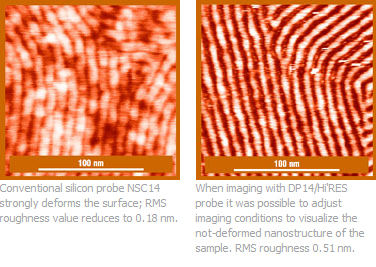Since its very discovery, AFM has held the great promise as a technique of choice for non-destructive surface measurements. To achieve this goal, one need to decrease to a minimum the tip-sample interaction force. The strong interaction force can bring about deformation and/or destruction of the surface of soft, fragile, liquid and weakly adhering samples
| Fig. 1. Images of liquid crystalline nanotexture of polypeptide with mini-dendritic groups. Images are obtained in tapping mode on Veeco Dimension 5000 AFM. Images are courtesy of Dr. S. Magonov (Veeco). Sample courtesy of Prof. V. Percec, (University of Pennsylvania, Phyladelphia, USA). |
 |
Soft and fragile samples can be imaged in non-contact and tapping mode only. Contact mode AFM is characterized by the presence of uncontrollable shear forces able to modify the morphological features.
To avoid sample deformation due to mechanical contact with the AFM tip in tapping mode, the tip-sample interaction force must be decreased to a minimum by using sharp AFM tips, soft AFM cantilevers, smaller amplitudes, and higher set-point ratios. High-resolution images of soft samples can be obtained by regular Tapping mode or Soft Tapping Mode AFM probes; however, a better performance is achieved using High Resolution AFM probes.
Tapping mode
Hi'Res-C AFM probes (Rtip <1nm) having soft AFM cantilevers with a spring constant of 5N/m or lower are recommended for scanning delicate samples in tapping mode. "Light" tapping conditions including small free AFM cantilever amplitudes (0.1-0.2V) and high setpoint ratios (0.8-0.95) provide stable imaging. Under light tapping conditions, Hi'Res-C AFM probes do not break and remain clean during long-term measurements.
However, extra attention should be paid to engagement of Hi'Res-C AFM probes. Scan rate should start at below 1Hz. Scan size should start out at 50nmx50nm.
Non-contact mode
Non-destructive surface imaging is also attainable in non-contact mode under ultra high vacuum conditions using regular silicon or Hi'Res-C AFM probes. AFM cantilevers of the HQ:NSC15 Series with high spring constants of 20-100N/m and high resonance frequency over 300kHz are usually used in this mode.